EDU650: Assessment's Role in School Improvement & Instruction
VerifiedAdded on 2023/06/03
|7
|1480
|266
Essay
AI Summary
This essay explores the crucial role of assessment and evaluation in enhancing school improvement quality. It delves into various assessment types, including diagnostic, evaluative, norm-referenced, interim, formative, and summative assessments, highlighting their unique values and contributions to student progress and instructional effectiveness. The essay also examines the significance of Common Core Standards in preparing students for college and future careers. Ultimately, it emphasizes that both assessment and evaluation are essential for driving progress in students' academic performance and the overall quality of the educational system. Desklib provides access to this essay and a wealth of other resources for students.
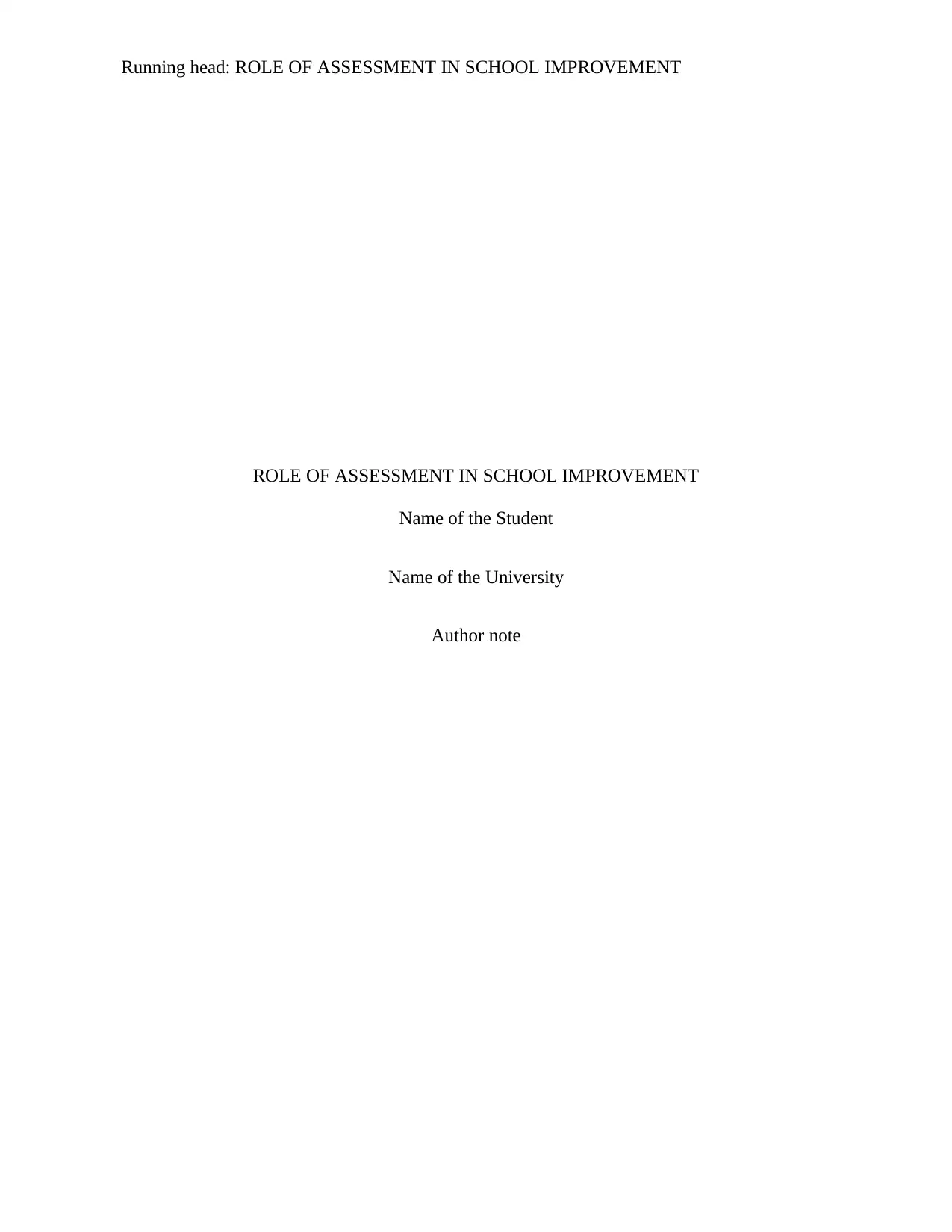
Running head: ROLE OF ASSESSMENT IN SCHOOL IMPROVEMENT
ROLE OF ASSESSMENT IN SCHOOL IMPROVEMENT
Name of the Student
Name of the University
Author note
ROLE OF ASSESSMENT IN SCHOOL IMPROVEMENT
Name of the Student
Name of the University
Author note
Paraphrase This Document
Need a fresh take? Get an instant paraphrase of this document with our AI Paraphraser
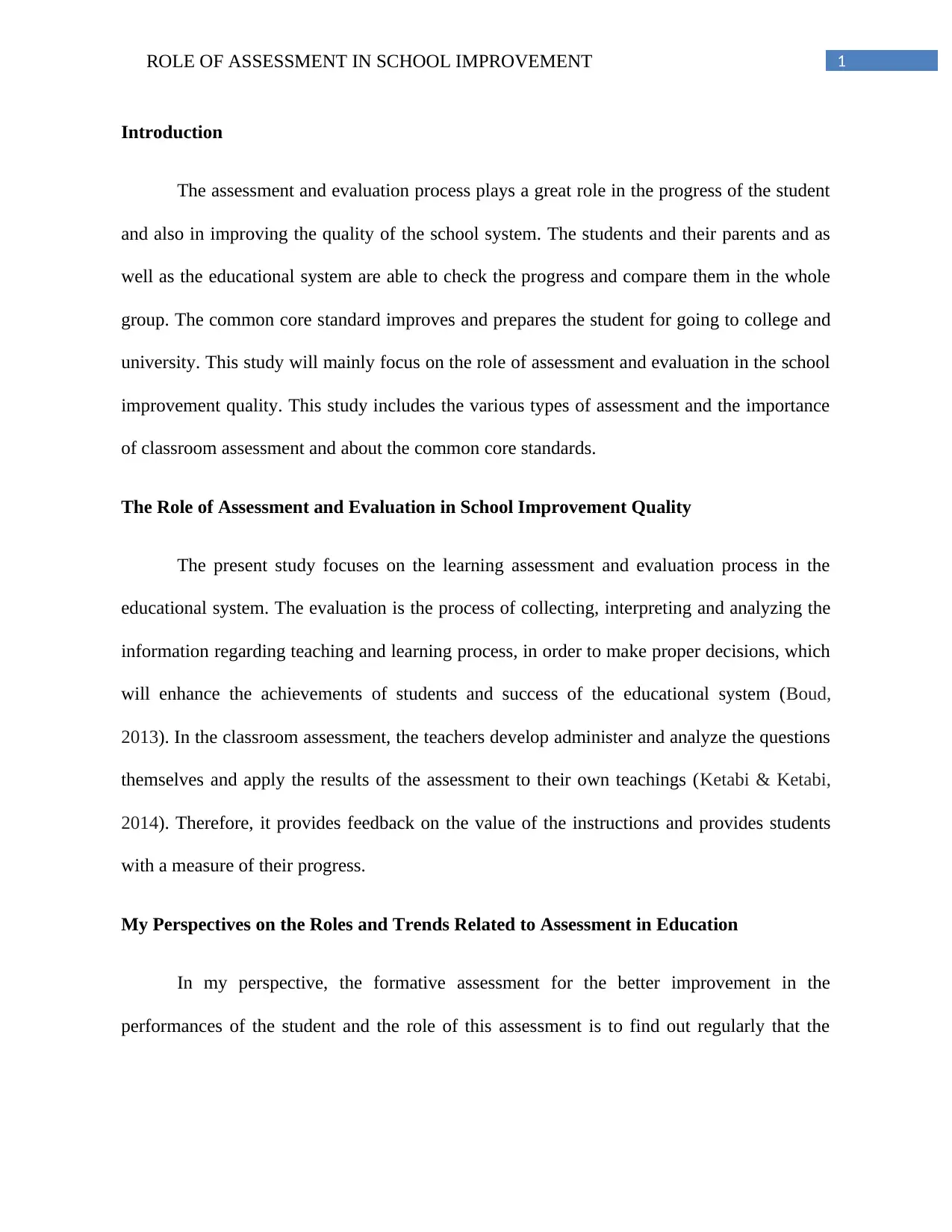
1ROLE OF ASSESSMENT IN SCHOOL IMPROVEMENT
Introduction
The assessment and evaluation process plays a great role in the progress of the student
and also in improving the quality of the school system. The students and their parents and as
well as the educational system are able to check the progress and compare them in the whole
group. The common core standard improves and prepares the student for going to college and
university. This study will mainly focus on the role of assessment and evaluation in the school
improvement quality. This study includes the various types of assessment and the importance
of classroom assessment and about the common core standards.
The Role of Assessment and Evaluation in School Improvement Quality
The present study focuses on the learning assessment and evaluation process in the
educational system. The evaluation is the process of collecting, interpreting and analyzing the
information regarding teaching and learning process, in order to make proper decisions, which
will enhance the achievements of students and success of the educational system (Boud,
2013). In the classroom assessment, the teachers develop administer and analyze the questions
themselves and apply the results of the assessment to their own teachings (Ketabi & Ketabi,
2014). Therefore, it provides feedback on the value of the instructions and provides students
with a measure of their progress.
My Perspectives on the Roles and Trends Related to Assessment in Education
In my perspective, the formative assessment for the better improvement in the
performances of the student and the role of this assessment is to find out regularly that the
Introduction
The assessment and evaluation process plays a great role in the progress of the student
and also in improving the quality of the school system. The students and their parents and as
well as the educational system are able to check the progress and compare them in the whole
group. The common core standard improves and prepares the student for going to college and
university. This study will mainly focus on the role of assessment and evaluation in the school
improvement quality. This study includes the various types of assessment and the importance
of classroom assessment and about the common core standards.
The Role of Assessment and Evaluation in School Improvement Quality
The present study focuses on the learning assessment and evaluation process in the
educational system. The evaluation is the process of collecting, interpreting and analyzing the
information regarding teaching and learning process, in order to make proper decisions, which
will enhance the achievements of students and success of the educational system (Boud,
2013). In the classroom assessment, the teachers develop administer and analyze the questions
themselves and apply the results of the assessment to their own teachings (Ketabi & Ketabi,
2014). Therefore, it provides feedback on the value of the instructions and provides students
with a measure of their progress.
My Perspectives on the Roles and Trends Related to Assessment in Education
In my perspective, the formative assessment for the better improvement in the
performances of the student and the role of this assessment is to find out regularly that the
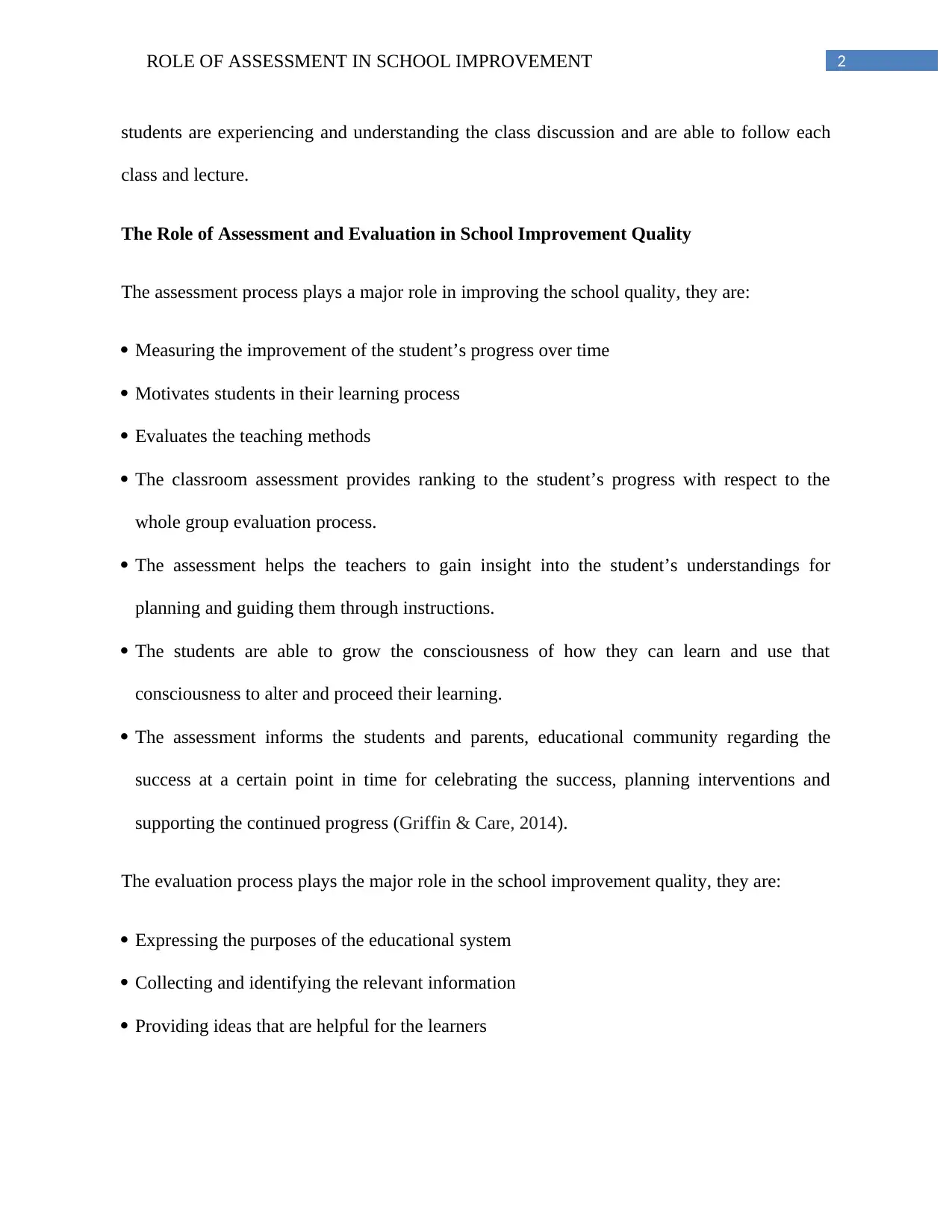
2ROLE OF ASSESSMENT IN SCHOOL IMPROVEMENT
students are experiencing and understanding the class discussion and are able to follow each
class and lecture.
The Role of Assessment and Evaluation in School Improvement Quality
The assessment process plays a major role in improving the school quality, they are:
Measuring the improvement of the student’s progress over time
Motivates students in their learning process
Evaluates the teaching methods
The classroom assessment provides ranking to the student’s progress with respect to the
whole group evaluation process.
The assessment helps the teachers to gain insight into the student’s understandings for
planning and guiding them through instructions.
The students are able to grow the consciousness of how they can learn and use that
consciousness to alter and proceed their learning.
The assessment informs the students and parents, educational community regarding the
success at a certain point in time for celebrating the success, planning interventions and
supporting the continued progress (Griffin & Care, 2014).
The evaluation process plays the major role in the school improvement quality, they are:
Expressing the purposes of the educational system
Collecting and identifying the relevant information
Providing ideas that are helpful for the learners
students are experiencing and understanding the class discussion and are able to follow each
class and lecture.
The Role of Assessment and Evaluation in School Improvement Quality
The assessment process plays a major role in improving the school quality, they are:
Measuring the improvement of the student’s progress over time
Motivates students in their learning process
Evaluates the teaching methods
The classroom assessment provides ranking to the student’s progress with respect to the
whole group evaluation process.
The assessment helps the teachers to gain insight into the student’s understandings for
planning and guiding them through instructions.
The students are able to grow the consciousness of how they can learn and use that
consciousness to alter and proceed their learning.
The assessment informs the students and parents, educational community regarding the
success at a certain point in time for celebrating the success, planning interventions and
supporting the continued progress (Griffin & Care, 2014).
The evaluation process plays the major role in the school improvement quality, they are:
Expressing the purposes of the educational system
Collecting and identifying the relevant information
Providing ideas that are helpful for the learners
⊘ This is a preview!⊘
Do you want full access?
Subscribe today to unlock all pages.

Trusted by 1+ million students worldwide
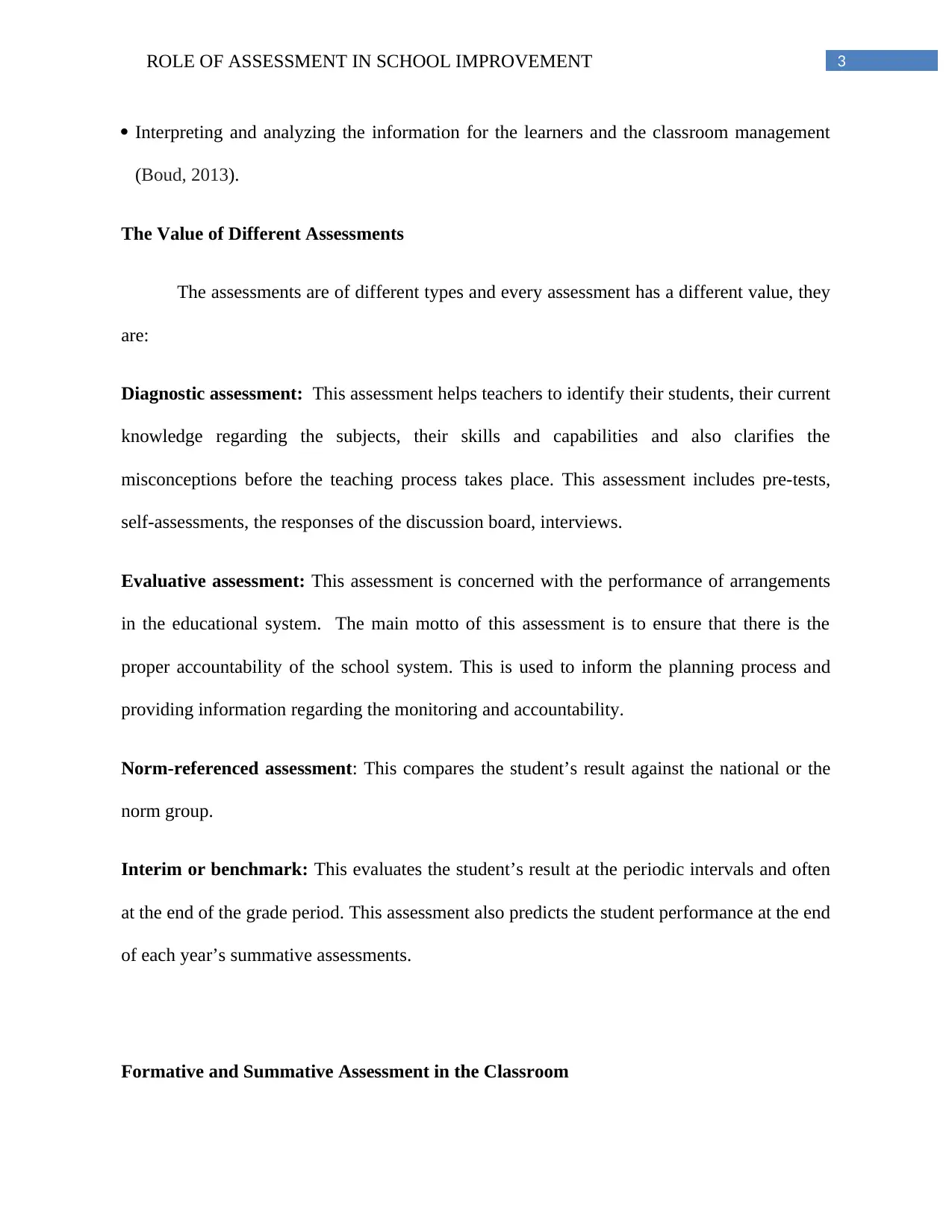
3ROLE OF ASSESSMENT IN SCHOOL IMPROVEMENT
Interpreting and analyzing the information for the learners and the classroom management
(Boud, 2013).
The Value of Different Assessments
The assessments are of different types and every assessment has a different value, they
are:
Diagnostic assessment: This assessment helps teachers to identify their students, their current
knowledge regarding the subjects, their skills and capabilities and also clarifies the
misconceptions before the teaching process takes place. This assessment includes pre-tests,
self-assessments, the responses of the discussion board, interviews.
Evaluative assessment: This assessment is concerned with the performance of arrangements
in the educational system. The main motto of this assessment is to ensure that there is the
proper accountability of the school system. This is used to inform the planning process and
providing information regarding the monitoring and accountability.
Norm-referenced assessment: This compares the student’s result against the national or the
norm group.
Interim or benchmark: This evaluates the student’s result at the periodic intervals and often
at the end of the grade period. This assessment also predicts the student performance at the end
of each year’s summative assessments.
Formative and Summative Assessment in the Classroom
Interpreting and analyzing the information for the learners and the classroom management
(Boud, 2013).
The Value of Different Assessments
The assessments are of different types and every assessment has a different value, they
are:
Diagnostic assessment: This assessment helps teachers to identify their students, their current
knowledge regarding the subjects, their skills and capabilities and also clarifies the
misconceptions before the teaching process takes place. This assessment includes pre-tests,
self-assessments, the responses of the discussion board, interviews.
Evaluative assessment: This assessment is concerned with the performance of arrangements
in the educational system. The main motto of this assessment is to ensure that there is the
proper accountability of the school system. This is used to inform the planning process and
providing information regarding the monitoring and accountability.
Norm-referenced assessment: This compares the student’s result against the national or the
norm group.
Interim or benchmark: This evaluates the student’s result at the periodic intervals and often
at the end of the grade period. This assessment also predicts the student performance at the end
of each year’s summative assessments.
Formative and Summative Assessment in the Classroom
Paraphrase This Document
Need a fresh take? Get an instant paraphrase of this document with our AI Paraphraser
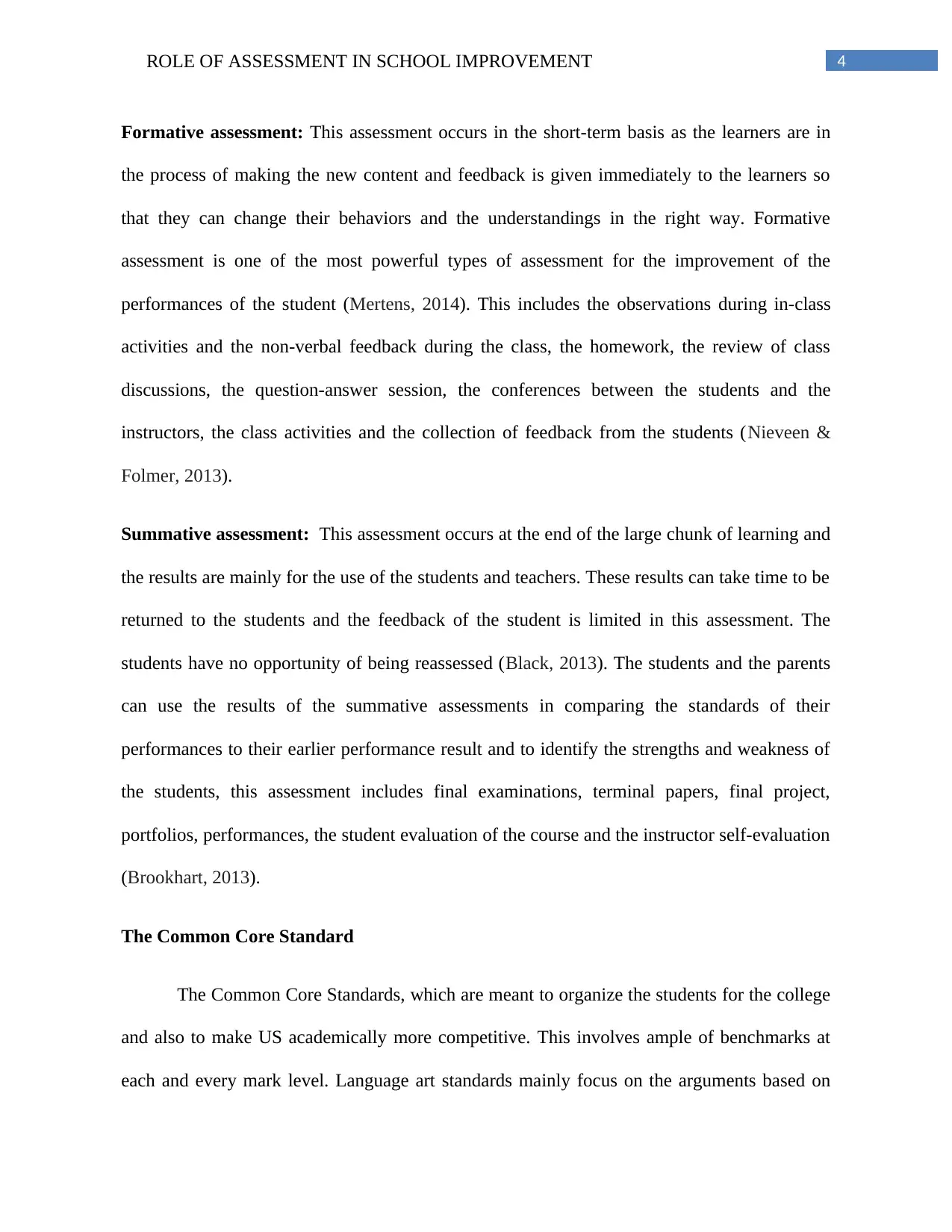
4ROLE OF ASSESSMENT IN SCHOOL IMPROVEMENT
Formative assessment: This assessment occurs in the short-term basis as the learners are in
the process of making the new content and feedback is given immediately to the learners so
that they can change their behaviors and the understandings in the right way. Formative
assessment is one of the most powerful types of assessment for the improvement of the
performances of the student (Mertens, 2014). This includes the observations during in-class
activities and the non-verbal feedback during the class, the homework, the review of class
discussions, the question-answer session, the conferences between the students and the
instructors, the class activities and the collection of feedback from the students (Nieveen &
Folmer, 2013).
Summative assessment: This assessment occurs at the end of the large chunk of learning and
the results are mainly for the use of the students and teachers. These results can take time to be
returned to the students and the feedback of the student is limited in this assessment. The
students have no opportunity of being reassessed (Black, 2013). The students and the parents
can use the results of the summative assessments in comparing the standards of their
performances to their earlier performance result and to identify the strengths and weakness of
the students, this assessment includes final examinations, terminal papers, final project,
portfolios, performances, the student evaluation of the course and the instructor self-evaluation
(Brookhart, 2013).
The Common Core Standard
The Common Core Standards, which are meant to organize the students for the college
and also to make US academically more competitive. This involves ample of benchmarks at
each and every mark level. Language art standards mainly focus on the arguments based on
Formative assessment: This assessment occurs in the short-term basis as the learners are in
the process of making the new content and feedback is given immediately to the learners so
that they can change their behaviors and the understandings in the right way. Formative
assessment is one of the most powerful types of assessment for the improvement of the
performances of the student (Mertens, 2014). This includes the observations during in-class
activities and the non-verbal feedback during the class, the homework, the review of class
discussions, the question-answer session, the conferences between the students and the
instructors, the class activities and the collection of feedback from the students (Nieveen &
Folmer, 2013).
Summative assessment: This assessment occurs at the end of the large chunk of learning and
the results are mainly for the use of the students and teachers. These results can take time to be
returned to the students and the feedback of the student is limited in this assessment. The
students have no opportunity of being reassessed (Black, 2013). The students and the parents
can use the results of the summative assessments in comparing the standards of their
performances to their earlier performance result and to identify the strengths and weakness of
the students, this assessment includes final examinations, terminal papers, final project,
portfolios, performances, the student evaluation of the course and the instructor self-evaluation
(Brookhart, 2013).
The Common Core Standard
The Common Core Standards, which are meant to organize the students for the college
and also to make US academically more competitive. This involves ample of benchmarks at
each and every mark level. Language art standards mainly focus on the arguments based on
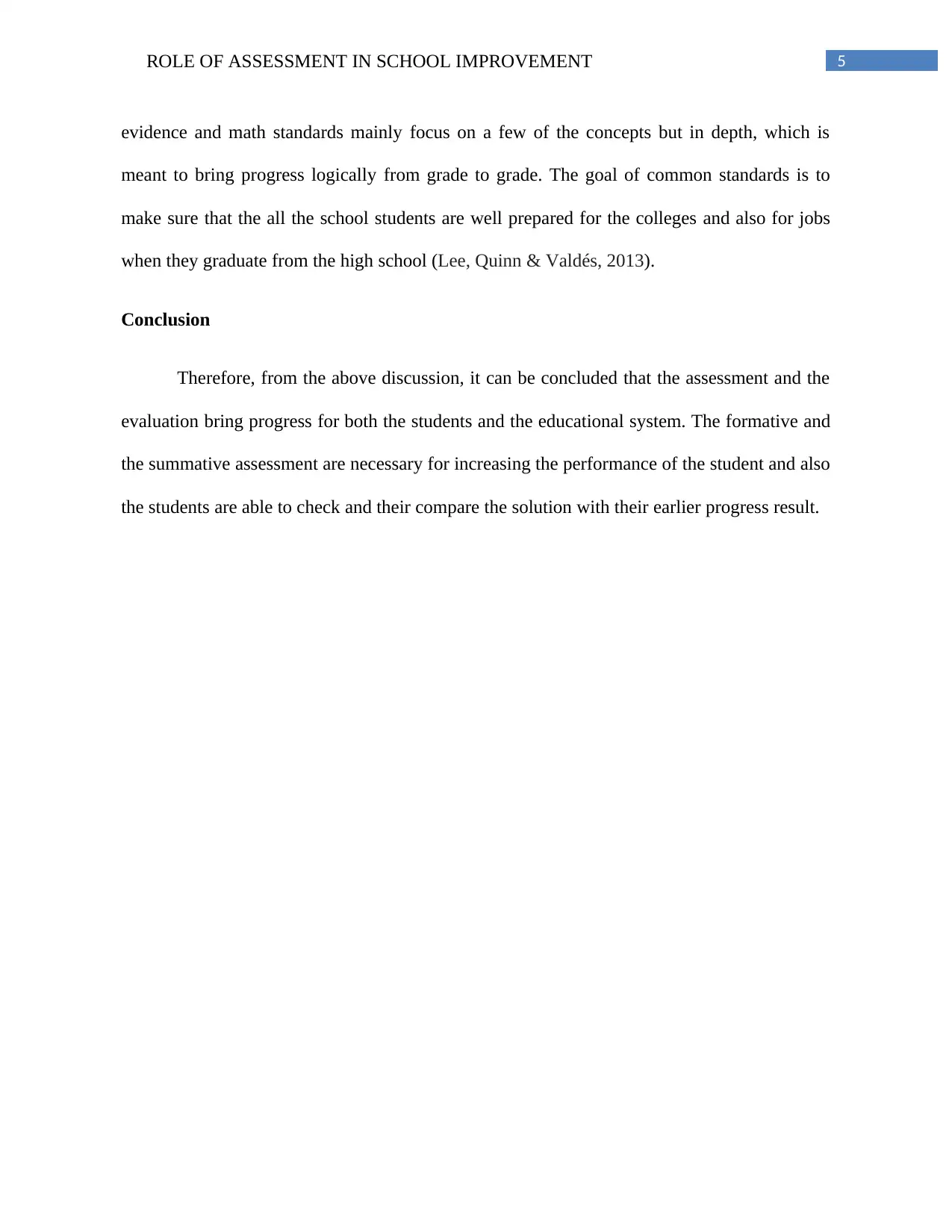
5ROLE OF ASSESSMENT IN SCHOOL IMPROVEMENT
evidence and math standards mainly focus on a few of the concepts but in depth, which is
meant to bring progress logically from grade to grade. The goal of common standards is to
make sure that the all the school students are well prepared for the colleges and also for jobs
when they graduate from the high school (Lee, Quinn & Valdés, 2013).
Conclusion
Therefore, from the above discussion, it can be concluded that the assessment and the
evaluation bring progress for both the students and the educational system. The formative and
the summative assessment are necessary for increasing the performance of the student and also
the students are able to check and their compare the solution with their earlier progress result.
evidence and math standards mainly focus on a few of the concepts but in depth, which is
meant to bring progress logically from grade to grade. The goal of common standards is to
make sure that the all the school students are well prepared for the colleges and also for jobs
when they graduate from the high school (Lee, Quinn & Valdés, 2013).
Conclusion
Therefore, from the above discussion, it can be concluded that the assessment and the
evaluation bring progress for both the students and the educational system. The formative and
the summative assessment are necessary for increasing the performance of the student and also
the students are able to check and their compare the solution with their earlier progress result.
⊘ This is a preview!⊘
Do you want full access?
Subscribe today to unlock all pages.

Trusted by 1+ million students worldwide
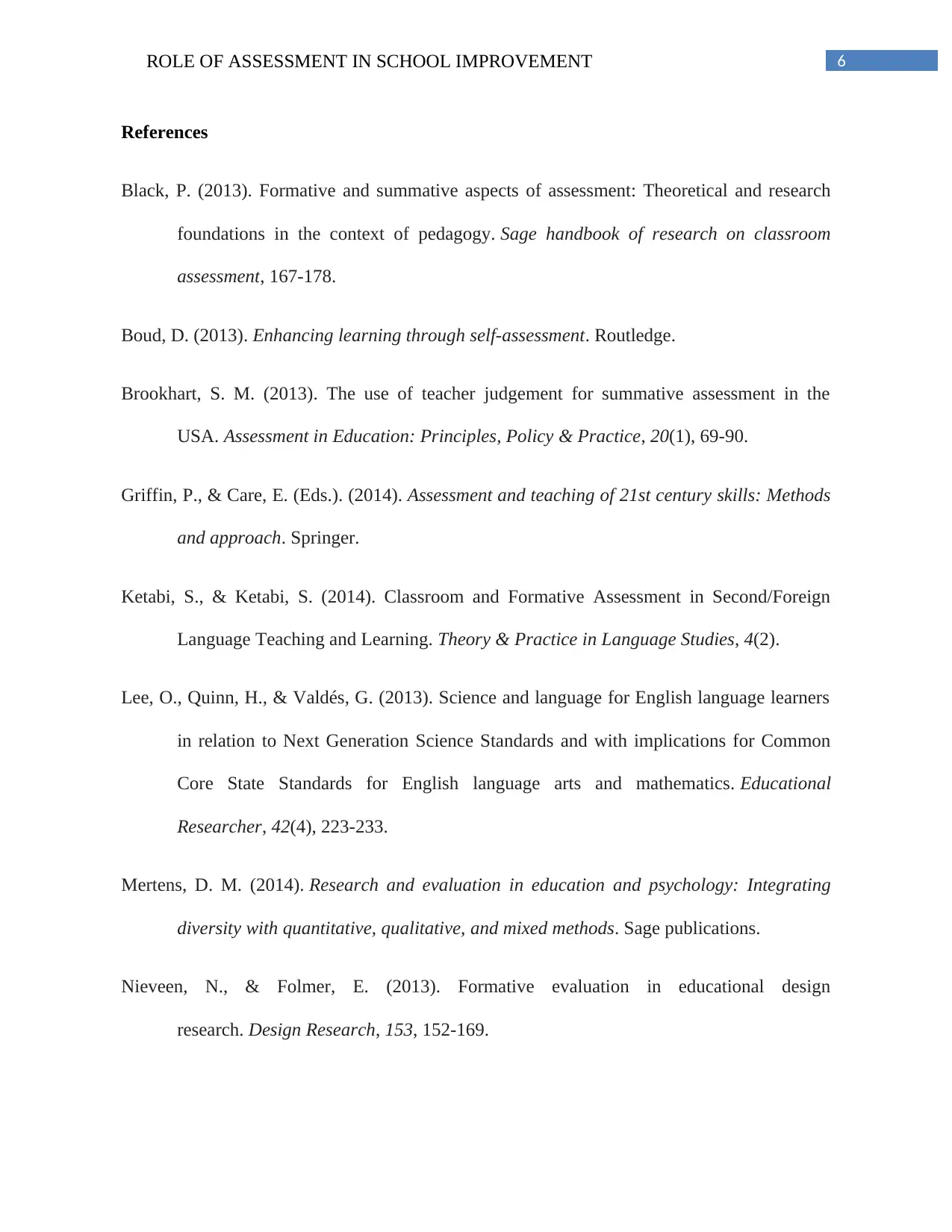
6ROLE OF ASSESSMENT IN SCHOOL IMPROVEMENT
References
Black, P. (2013). Formative and summative aspects of assessment: Theoretical and research
foundations in the context of pedagogy. Sage handbook of research on classroom
assessment, 167-178.
Boud, D. (2013). Enhancing learning through self-assessment. Routledge.
Brookhart, S. M. (2013). The use of teacher judgement for summative assessment in the
USA. Assessment in Education: Principles, Policy & Practice, 20(1), 69-90.
Griffin, P., & Care, E. (Eds.). (2014). Assessment and teaching of 21st century skills: Methods
and approach. Springer.
Ketabi, S., & Ketabi, S. (2014). Classroom and Formative Assessment in Second/Foreign
Language Teaching and Learning. Theory & Practice in Language Studies, 4(2).
Lee, O., Quinn, H., & Valdés, G. (2013). Science and language for English language learners
in relation to Next Generation Science Standards and with implications for Common
Core State Standards for English language arts and mathematics. Educational
Researcher, 42(4), 223-233.
Mertens, D. M. (2014). Research and evaluation in education and psychology: Integrating
diversity with quantitative, qualitative, and mixed methods. Sage publications.
Nieveen, N., & Folmer, E. (2013). Formative evaluation in educational design
research. Design Research, 153, 152-169.
References
Black, P. (2013). Formative and summative aspects of assessment: Theoretical and research
foundations in the context of pedagogy. Sage handbook of research on classroom
assessment, 167-178.
Boud, D. (2013). Enhancing learning through self-assessment. Routledge.
Brookhart, S. M. (2013). The use of teacher judgement for summative assessment in the
USA. Assessment in Education: Principles, Policy & Practice, 20(1), 69-90.
Griffin, P., & Care, E. (Eds.). (2014). Assessment and teaching of 21st century skills: Methods
and approach. Springer.
Ketabi, S., & Ketabi, S. (2014). Classroom and Formative Assessment in Second/Foreign
Language Teaching and Learning. Theory & Practice in Language Studies, 4(2).
Lee, O., Quinn, H., & Valdés, G. (2013). Science and language for English language learners
in relation to Next Generation Science Standards and with implications for Common
Core State Standards for English language arts and mathematics. Educational
Researcher, 42(4), 223-233.
Mertens, D. M. (2014). Research and evaluation in education and psychology: Integrating
diversity with quantitative, qualitative, and mixed methods. Sage publications.
Nieveen, N., & Folmer, E. (2013). Formative evaluation in educational design
research. Design Research, 153, 152-169.
1 out of 7
Related Documents
Your All-in-One AI-Powered Toolkit for Academic Success.
+13062052269
info@desklib.com
Available 24*7 on WhatsApp / Email
![[object Object]](/_next/static/media/star-bottom.7253800d.svg)
Unlock your academic potential
Copyright © 2020–2025 A2Z Services. All Rights Reserved. Developed and managed by ZUCOL.





